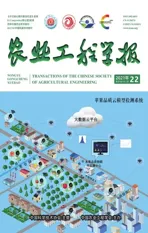手持式可见近红外苹果品质无损检测系统设计与试验
2021-02-19郭志明王郡艺殷晓平邹彩霞邹小波
郭志明,王郡艺,宋 烨,殷晓平,邹彩霞,邹小波
·农产品加工工程·
手持式可见近红外苹果品质无损检测系统设计与试验
郭志明1,王郡艺1,宋 烨2,殷晓平3,邹彩霞1,邹小波1
(1. 江苏大学食品与生物工程学院,镇江 212013;2. 中华全国供销合作总社济南果品研究院,济南 250220;3. 苏州晓创光电科技有限公司,苏州 215505)
为实现苹果多产地多品质指标的现场快速无损检测与评价,该研究基于可见近红外光谱技术研发低成本、低功耗、小型化的苹果品质手持式无损检测终端。检测终端集成宽谱LED光源和水果特征响应窄带光电探测器,接入物联网云端数据系统,实现检测数据上传和模型的远程更新维护。利用研制的检测系统可有效获取不同产区苹果500~1 050 nm波长范围内的漫反射光谱,优选光谱预处理算法消除干扰并采用不同特征波长提取算法对数据进行降维,分别建立了多产地苹果可溶性固形物含量、硬度和维生素C含量的通用检测模型,模型的预测相关系数分别为0.926、0.798和0.704,预测均方根误差分别为0.585%、1.405 kg/cm2和0.968 mg/100g。将通用检测模型载入云端数据系统作为云模型,检测样本时调用云模型进行计算并反馈至检测终端。通过多个产地独立样本的验证表明,该系统可满足苹果产业现场无损检测的实际需求,为手持式光谱检测仪的实用化设计提供参考。
无损检测;近红外光谱;苹果品质;云模型;多产地;手持式检测系统
0 引 言
中国是世界上苹果种植和消费的第一大国[1],国家统计局数据显示,近年来中国苹果产量总体呈惯性扩张态势。苹果营养价值丰富,包含多种维生素、氨基酸、膳食纤维等功能成分,具有延缓衰老、降低胆固醇等功效[2]。苹果消费已由数量型向质量型转变,由关注外观品质向内部品质转变,依据苹果内部品质分级可以提高苹果的附加值。苹果产业迫切需要内部品质快速无损检测分级评价技术与设备,但现有的无损检测系统存在复杂环境抗干扰能力差、建模成本高、模型适用性差、传感器系统复杂等问题,严重制约了该技术的实用化[3]。
无损检测技术利用声、光、电等手段检测水果的化学成分和物理特性,常用的水果无损检测技术包括光谱技术、介电特性技术、核磁共振技术、计算机断层扫描技术等[4]。可见近红外光谱技术因操作简便、精确度高、客观无损而成为目前最有潜力的水果内部品质无损检测技术[5-6]。可见近红外光谱主要是含氢基团分子振动倍频和合频的吸收光谱,包含被测样本内部品质的相关信息。苹果内部组分含有丰富的含氢基团,内部品质指标适用于可见近红外光谱检测[7-8]。目前,可见近红外光谱技术在苹果内部质量检测已开展广泛的研究[9-13],然而受产地、品种、收获年份、果园管理模式等的影响,苹果在成熟和贮藏过程中品质易发生变化[14],传统模型的预测效果不能满足实际需求且模型的更新和维护也较为困难,模型的稳定性和适用性制约了可见近红外光谱技术的推广应用[15-17]。此外,目前利用可见近红外光谱技术的水果品质无损检测设备多使用集成光谱仪进行二次开发,光源常使用卤钨灯,成本和能耗均较高,不利于在食品、农产品加工检测行业推广应用。研发小型化、低成本、低功耗的适用于多产地苹果品质无损检测系统,在苹果质量评测上具有广阔的应用前景[18-20]。
物联网、大数据和云服务等新技术正快速推进农业智能化发展[21-22]。研究将建立的苹果内部品质预测模型上载至云端服务器,通过5G/4G传输模块与云模型进行交互,检测结果实时回传,方便模型的优化与更新。本研究集成宽谱LED光源和水果特征响应窄带光电探测器,进行电路设计和软硬件系统开发,建立多产地苹果品质通用检测模型,研制苹果品质云模型的手持式可见近红外无损检测系统,以期实现苹果内部品质快速无损原位检测,为保障苹果质量安全、增加苹果附加值、提高中国苹果国际竞争力等提供参考。
1 苹果品质云模型的手持式可见近红外无损检测系统设计
苹果品质云模型的手持式可见近红外无损检测系统由手持式检测终端和物联网云端数据系统组成。手持式检测终端获取苹果光谱信息,通过通讯模块将数据传输至物联网云端数据系统,对模型库中对应模型进行调用并计算,预测结果返回至检测终端,同时将结果保存于检测数据库,方便数据查询下载和统计分析。
手持式检测终端硬件主要由光源、可见近红外光电传感器、温度传感器、可充电式锂电池、显示屏、控制电路、遮光圈、橡胶垫圈和壳体组成,如图1所示。LED点光源呈圆周对称排布,工作时将苹果放置于检测部位,检测部位设计橡胶垫圈以防止苹果受到机械损伤,并可隔绝漫反射光以外的杂散光,同时配置遮光圈,保证检测时不受环境光的干扰,特别是室外光照环境。触动检测开关,光线以固定角度照射苹果,经内部传输后漫反射光被可见近红外光电传感器所接收,由控制电路将信号进行处理并通过4G/5G模块传输至云服务器,调用云模型获取检测结果。
1.1 微型光源模块
可见近红外光谱检测系统需配置宽波段的光源,一般选用卤钨灯[23],但具有高功耗、低光利用率等问题,导致检测系统大而重,限制了可见近红外光谱技术现场、户外快速无损检测领域的应用推广。定制开发宽谱LED光源,光强在550~1 000 nm波段范围内随频率变化呈连续高强度分布,可以实现苹果多品质指标同时检测。此宽谱LED构建的环形光源组具有体积小、重量轻、发光均匀、响应速度快、抗震防水能力强、功耗低、使用寿命长等特点,可以在户外环境中使用。LED光源发出的光线是定向的,总功率仅为72 mW,大部分光线能直接投射向苹果表面,具有一定的焦距和工作平面。此外,发光强度可以通过电流强弱进行有效控制,可根据苹果种类设置不同的光照强度以提高其通用性和适用性。
1.2 可见近红外光电传感器模块
随着微机电加工技术的发展,微型可见近红外光谱仪发展迅速,现有的微型光谱仪可以分为色散型可见近红外光谱仪、滤光片型可见近红外光谱仪、调制型可见近红外光谱仪等[24],具有体积小、集成度高、能耗低、便于二次开发等优点[25]。但其多数属于通用性分析仪器,成本较高,并且在特定条件下性能不够优良。本研究选用日本滨松公司生产的C14384MA-01超紧凑型可见近红外光电传感器,配置高灵敏度的CMOS线性传感器,光谱有效响应范围为500~1 050 nm,质量仅为0.3 g,具有质量轻、体积小、成本低的特点,在可见近红外区分辨率为17 nm,能够获得连续波谱,满足水果内部品质的检测需求。
1.3 控制与通讯模块
光谱信号被可见近红外光电传感器获取后,由AD8092芯片设计的电路进行信号放大及基线调整,传至SAR架构的ADC模数转换芯片将光信号转换为电信号,最后通过嵌入式单片机进行处理。集成现场可编程逻辑门阵列(Field Programmable Gate Array,FPGA)控制整个电路的时序,保证电路正常工作,ADC器件和光电传感器的时序同步,数据平滑等预处理也通过FPGA进行处理,如图2a所示。嵌入式主板设有5G/4G和GPS模块,光谱数据被无线传输至云服务器,调用云模型进行计算,将检测结果回传至系统中并在显示屏上实时显示。在软件开发过程中,构建苹果内部品质监测平台,如图 2b所示。数据上传至云端数据系统到返回检测终端所用时间为1.5~2.0 s,测试的有效回传率达100%,检测结果记录于云端数据库,方便查询下载和统计分析,实现苹果品质原位实时检测和监测。
1.4 软件开发
苹果品质手持式可见近红外无损检测系统软件基于嵌入式实时操作系统Real Time-Thread进行模块化开发,使用C语言编写。模型调用具有两种模式,模式一为直接调用内置于检测系统中的模型实现单机实时获取结果,模式二为调用置于云服务器中的云模型便于模型的更新与维护。此外,检测结果存储于云端数据库,每条数据设置单独的序列号,方便查询下载分析,实现产区苹果品质评价。
2 苹果内部品质检测云模型的建立
从国家现代农业(苹果)产业技术体系各苹果实验站共获得来自17个产地的富士苹果529个,如表1所示。将苹果样品运输到实验室后,将其存储在4 ℃的冰箱中。试验之前,将苹果从冰箱中取出并在室温(25 ℃)下放置24 h,以减少由于温度变化而引起的测量误差。用湿纱布将所有样品擦拭干净并自然风干,然后将样品逐一编号,分批选择不同产地的样品进行试验。
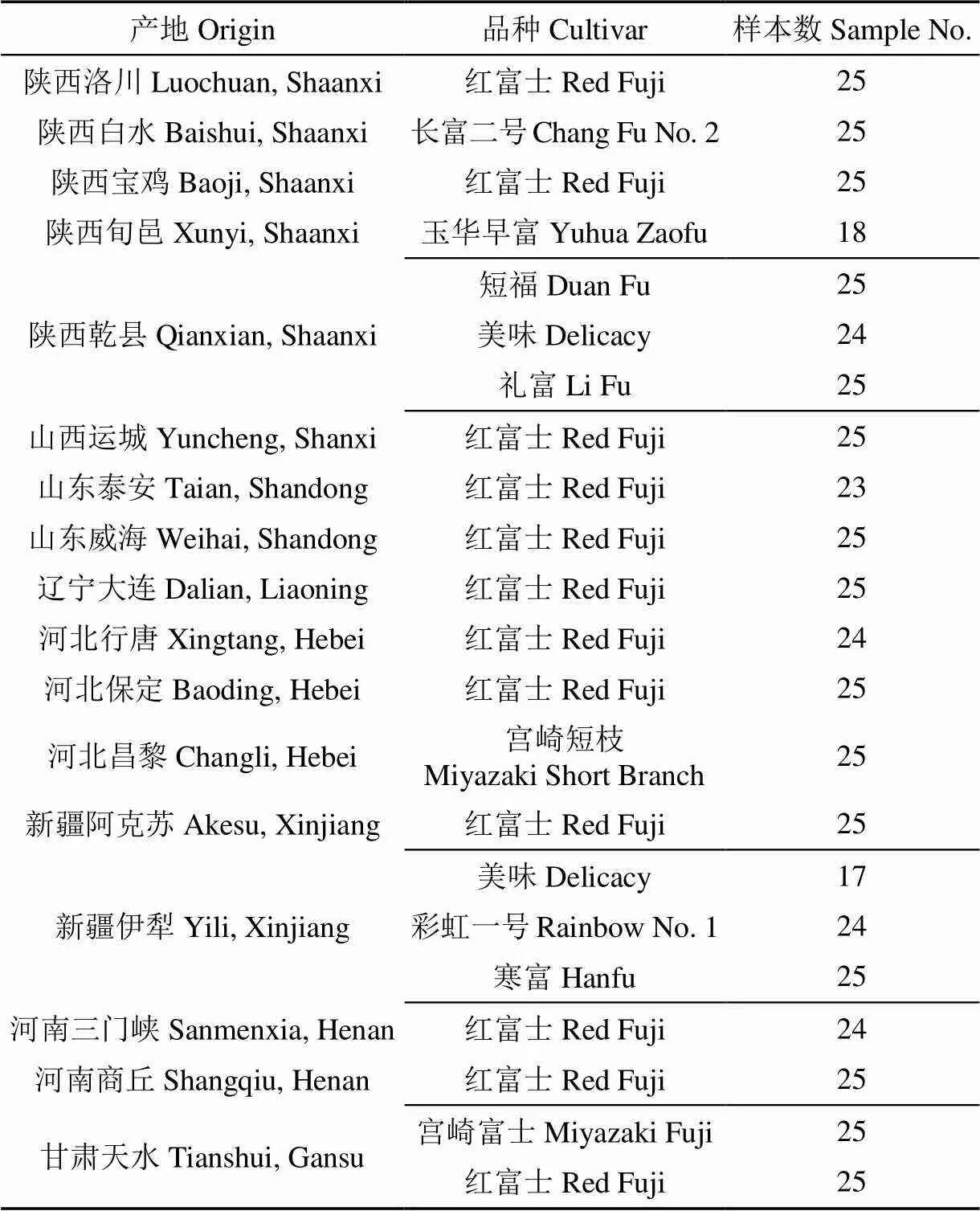
表1 苹果来源统计结果
2.1 苹果品质测定
苹果中的可溶性固形物含量(Soluble Solids Content,SSC)、硬度(Firmness)和维生素C含量(Vitamin C content)是评价苹果品质的重要指标。苹果SSC测定参考NY/T 2637—2014,采用折射仪法。使用的折射仪为ATAGO RX-5000α(ATAGO Company),测量前用蒸馏水对折射仪进行校正,用取样器取苹果赤道位置直径约1 cm果肉,用纱布挤压,将汁液滴入折射仪检测窗口,获得其SSC含量参考值。苹果硬度测定参考NY/T 2009 —2011,采用硬度计法。使用TA-XT plus物性仪(Stable Micro System Company),采用P2探头,预压速度为1.5 mm/s,穿刺速度为1.0 mm/s,压后上行速度为10.0 mm/s,测试距离为10 mm,触发力为0.049 N。苹果维生素C含量的测定参考GB 5009.86—2016,使用2, 6-二氯靛酚滴定法。
将529个苹果样本按照3∶2的比例随机划分为训练集和预测集,品质指标统计结果如表2所示,通过训练集和预测集样本的范围、均值和标准偏差等统计数据发现,样本选择具有较好的代表性和测试范围。
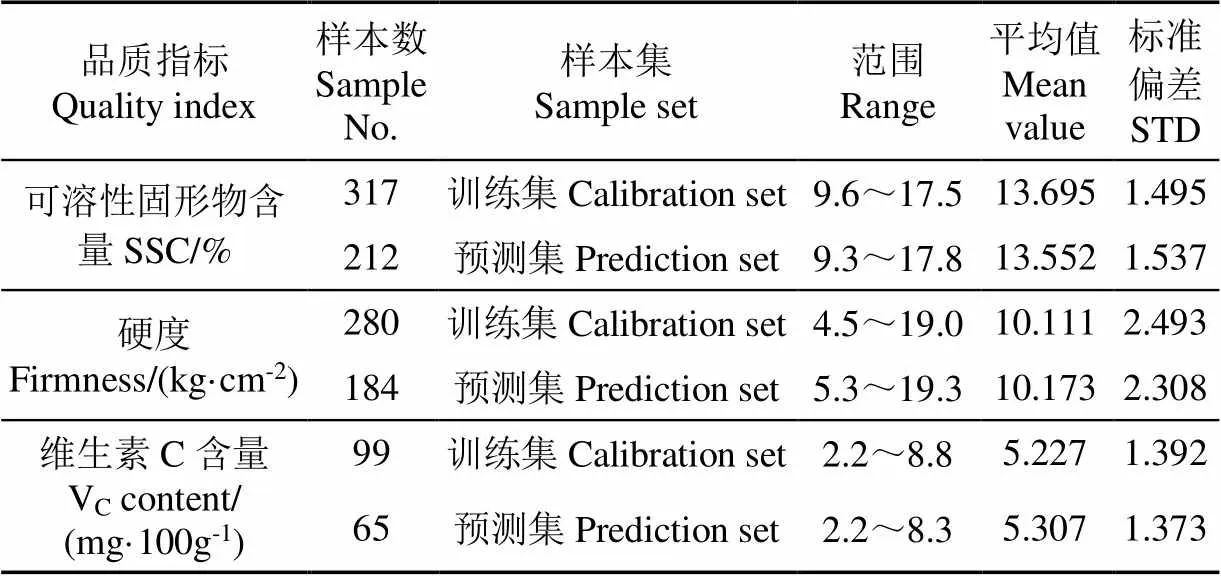
表2 苹果品质测定统计结果
注:范围、平均值、标准偏差的单位为各指标单位。
Note:The units of range, mean value and STD are indicator units.
2.2 苹果可见近红外光谱采集与数据分析
检测系统经优化设置平均次数为5,曝光时间为75 ms,采样频率为10 Hz,为消除暗噪声所带来的试验误差,采集水果光谱的同时采集其暗光谱与全反射光谱,并将光谱强度转化为相对吸光度lg(1/),得到光谱与样品组分含量的线性相关关系,其中为样品的相对透过率。删除无响应和噪声较大的光谱边缘区域,选择波长范围515~870 nm的光谱进行处理。
在可见近红外光谱区域,苹果中存在水和碳水化合物的C-H、O-H、N-H等化学键对应的典型重叠吸收[26]。图3为原始可见近红外光谱图,可以看出所有苹果样品的光谱特征都表现出类似的变化趋势。675 nm附近的吸收光谱与苹果皮中的叶绿素a、叶绿素b和花色苷有关[27]。760 nm附近的吸收峰与水和碳水化合物的含量相关[28]。因此,基于可见近红外漫反射光谱技术建立多产地苹果品质预测模型是可行的。
在光谱采集过程中,由于受到仪器和样品本身的干扰,原始光谱易受到谱峰重叠、基线漂移等影响,所建立的模型稳定性差、精度低。通过比较不同的光谱预处理方法发现Savitzky-Golay smoothing(SG平滑)可以有效提高模型的精度,经前期试验SG平滑多项式次数设置为2,窗口数设置为7。其原因为SG平滑有效消除了基线漂移和倾斜。
2.3 多产地苹果内部品质通用检测模型的建立
可见近红外光谱带包含无信息变量,变量选择算法可以对光谱信息进行优化组合以降低模型计算量,从而达到简化模型的目的。本研究使用无信息变量消除算法(Uninformative Variable Elimination Algorithm,UVE)[29],遗传算法(Genetic Algorithm,GA)[30],连续投影算法(Successive Projections Algorithm,SPA)[31]以及竞争性自适应重加权采样算法(Competitive Adaptive Reweighted Algorithm,CARS)[32]选择特征波长,利用偏最小二乘法(Partial Least Square,PLS)分别建立多产地苹果可溶性固形物含量、硬度和维生素C含量预测模型。模型性能使用训练集均方根误差(Root Mean Square Error of Calibration,RMSEC)和预测集均方根误差(Root Mean Square Error of Prediction,RMSEP)以及相关系数(R和R)进行评价,其建模结果如表3所示
对比经过不同特征波长选择算法处理的PLS模型结果选取最适合该样本的特征波长选择方案。以预测集相关系数为判别依据,当结果相当时选择变量数较少的为最优模型。苹果可溶性固形物含量模型的预测效果表现为CARS-PLS> SPA-PLS > UVE-PLS > GA-PLS。对于硬度模型,预测效果表现为GA-PLS>SPA-PLS>CARS-PLS> UVE-PLS。对于维生素C含量模型的预测效果表现为GA-PLS>SPA-PLS>UVE-PLS>CARS-PLS。SSC的CARS-PLS模型、硬度和维生素C含量的GA-PLS模型与全谱PLS模型相比,预测能力未有显著提升,但变量数减少近3/4,简化了模型。其模型散点如图4所示,使用训练集和预测集的分布表示模型的相关性。
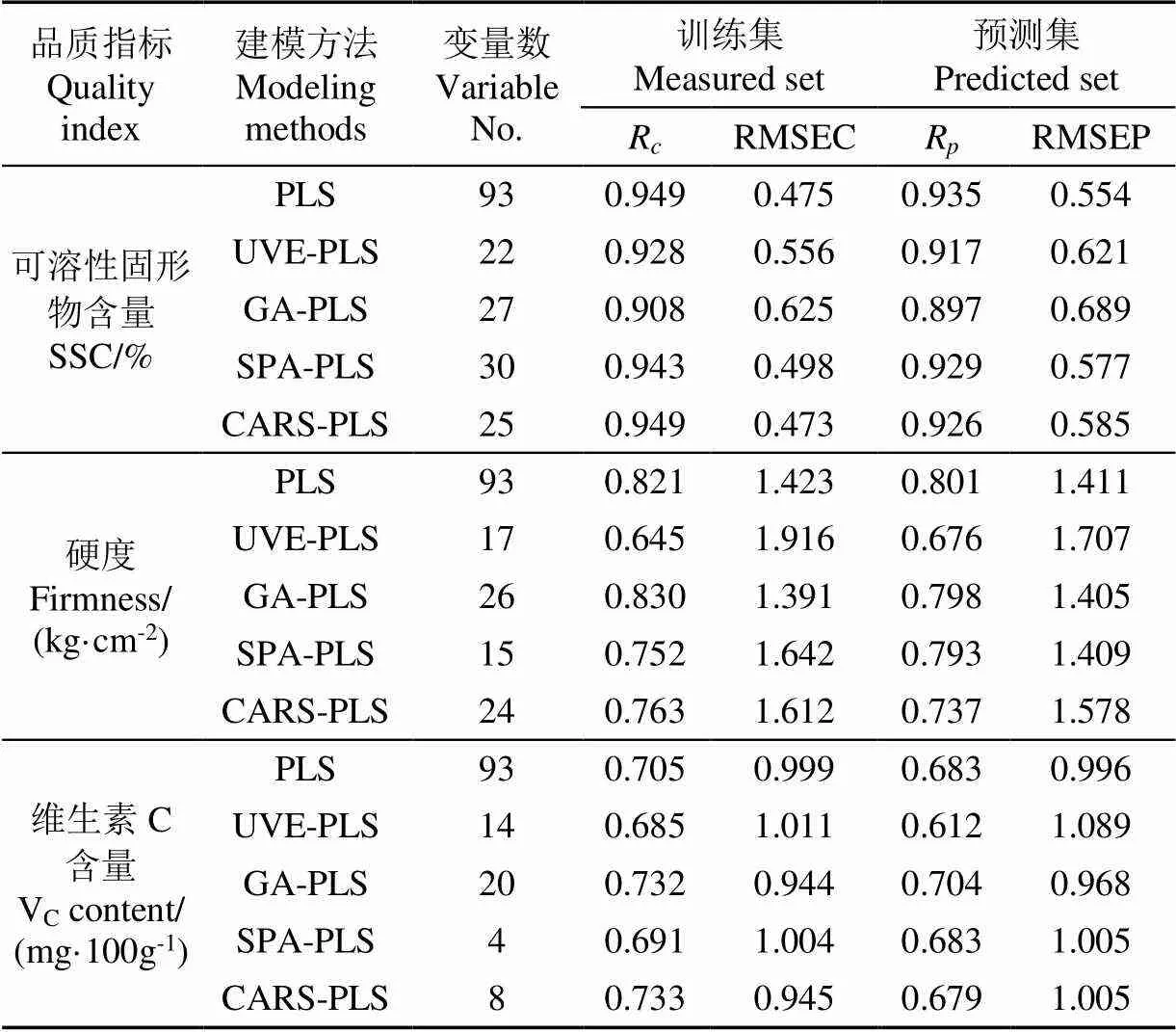
表3 不同变量选择算法的建模效果
注:R和R为训练集和预测集相关系数,RMSEC和RMSEP分别为训练集和预测集均方根误差,单位为各指标单位。下同。
Note:RandRare correlation coefficients of calibration set and prediction set, RMSEC and RMSEP are root mean square errors of calibration set and prediction set, and the unit is each indicator unit. Same as below.
CARS将原始数据集通过蒙特卡洛采样进行划分,通过指数衰减函数对主要选择变量进行优化,然后使用自适应加权采样技术对特征变量进行提取,最后以RMSEC值作为判断变量最佳组合的标准[33-34]。在蒙特卡罗采样过程中,RMSEC值随蒙特卡罗采样次数的增加先减小后增大,对可溶性固形物含量的特征变量在第5次采样时达到最小值。在相应的点选取25个特征变量,利用选取的变量建立PLS预测模型,可溶性固形物含量CARS-PLS模型的R=0.949,RMSEC=0.473%;R=0.926,RMSEP=0.585%。
GA是通过模拟生物进化过程搜索最优解的方法。对光谱区间515~870 nm间93个波长点进行二进制编码,将进化后选择的波长点进行建模,以RMSEC作为评价标准。在对硬度和维生素C含量编码过程中分别选取频率大于10和6的变量建立PLS模型。硬度GA-PLS模型的R=0.830,RMSEC=1.391 kg/cm2;R=0.798,RMSEP=1.405 kg/cm2,维生素C含量GA-PLS模型的R=0.732,RMSEC= 0.944 mg/100g;R=0.704,RMSEP=0.968 mg/100g。
硬度反映了苹果的质构特性,体现的是组织致密程度,与光的散射特性相关;维生素C因含量低、变化范围小,光谱响应信号相对较弱;硬度和维生素C的无损检测是行业内的技术难题,本文研发的检测系统基本与科研级的光谱仪的检测性能相当,已优于感官评价的精度,基本可以满足现场快速无损检测需求。
2.4 云模型的载入与验证
为评价云模型的适用性和稳定性,计算通用检测模型的多项式系数方程,手动输入至云端数据系统的模型数据库中,调用云模型进行了多产地验证应用。选取2个产地的红富士苹果样本各30个,使用手持式检测终端获取其光谱信息,调用云模型进行计算,利用独立预测相关系数R和独立预测均方根误差(Root Mean Square Error of Independent Prediction,RMSEI)评价模型的性能,结果如表4所示。
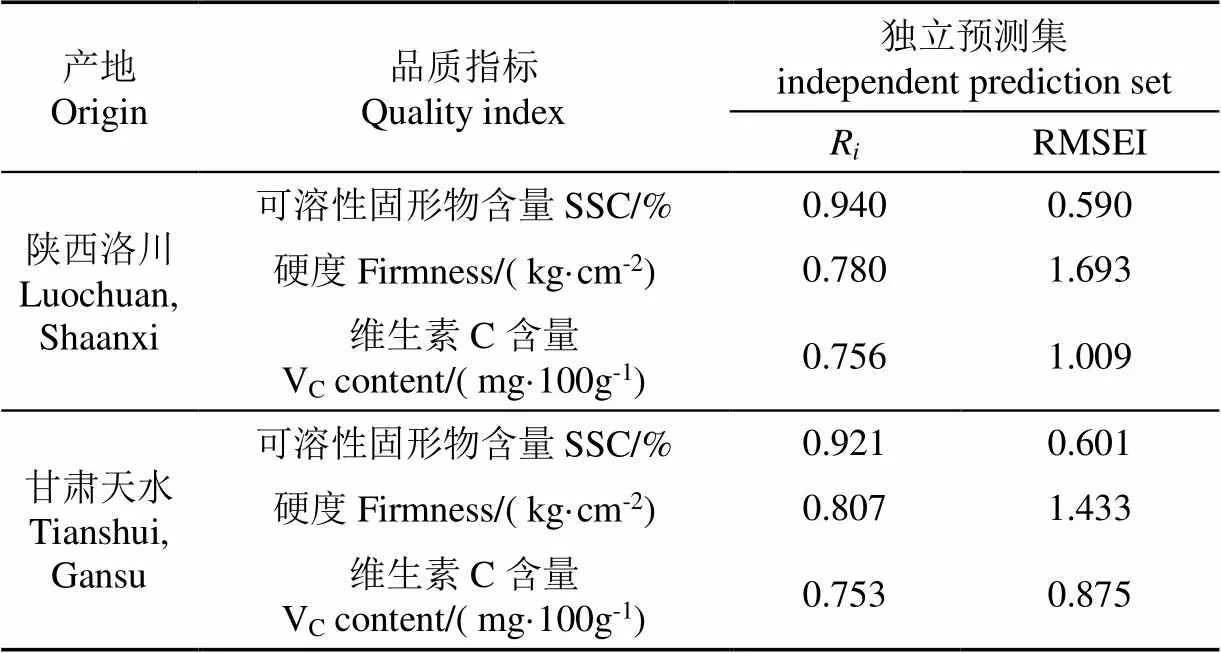
表4 单一产地通用模型验证结果
两个产地可溶性固形物含量、硬度和维生素C含量的独立预测相关系数R平均值分别为0.931、0.794和0.755,独立预测均方根误差平均值分别为0.596%,1.563 kg/cm2和0.942 mg/100g,通用模型在预测单一产地苹果品质时,由于其他产地品种影响,更多的生物特异性被考虑,预测精度对外部因素的变化并不敏感,使得检测模型对未知样本的检测更加稳健。
2.5 云模型的更新与维护
将建立的苹果内部品质检测模型载入云服务器上,研发的苹果品质手持式可见近红外无损检测系统通过光谱采集、数据传输、云模型调用、数据存储、结果反馈和显示实现检测。基于原有样本数据所建立的普适性预测云模型在实际应用中由于新品种、年份或检测环境的影响会导致预测精度下降,需定期进行模型的维护和更新。添加少量具有代表性的新样本,形成新的训练数据集,对云模型的回归系数进行更新[35-36],从而实现云模型的快速更新,提高云模型的适用性和稳定性。
3 结 论
1)基于可见/近红外漫反射光谱技术,设计并研制了苹果品质云模型的手持式可见近红外无损检测系统。集成宽谱LED光源和水果特征响应窄带光电探测器,在满足现场使用的同时可以实现苹果的可溶性固形物含量、硬度和维生素C含量等多品质指标同时检测。
2)以17个产地的苹果为样本,使用检测系统获取其光谱,经过Savitzky-Golay平滑预处理后使用竞争性自适应重加权采样算法和遗传算法分别进行特征波长提取以简化模型,分别建立多产地苹果的可溶性固形物含量、硬度和维生素C含量偏最小二乘通用检测模型可溶性固形物含量竞争性自适应重加权采样-偏最小二乘模型(Competitive Adaptive Reweighted Algorithm- Partial Least Square, CARS-PLS)预测相关系数R=0.926,预测均方根误差RMSEP=0.585%。硬度遗传-偏最小二乘模型(Genetic Algorithm- Partial Least Square, GA-PLS)的预测相关系数R=0.798,预测均方根误差RMSEP=1.405 kg/cm2,维生素C含量GA-PLS模型的预测相关系数R=0.704,预测均方根误差RMSEP= 0.968 mg/100g。
3)将通用检测模型上传至云服务器作为云模型,采集新样本光谱数据后调用云模型进行了单一产地的验证。两个产地可溶性固形物含量、硬度和维生素C含量的独立预测相关系数R平均值分别为0.931、0.794和0.755,独立预测均方根误差平均值分别为0.596%,1.563 kg/cm2和0.942 mg/100g,可以满足实际检测需求。
研究表明,所研发的苹果品质云模型的手持式可见近红外无损检测系统可以实现多产地苹果的多品质指标的快速无损检测,可为小型化、低成本的手持式水果品质检测系统的设计提供参考。进一步将苹果品质手持式可见近红外无损检测系统作为感知终端,动态跟踪各苹果产区的果品统计信息,长期监测树上苹果如可溶性固形物含量等品质特征的变化规律,形成反馈机制,依据苹果生长过程变化曲线,指导苹果种植管理,提高苹果整体优质率。另外,此系统可用于苹果产业下游期货的质量控制和上游育种质量监控,推动苹果产业智能化发展。本系统的开发和设计同样适用于其他类球形果蔬,将在进一步研究中进行验证应用。
[1] Zhang Q, Zhou B, Min-Ji L I, et al. Multivariate analysis between meteorological factor and fruit quality of Fuji apple at different locations in China[J]. Journal of Integrative Agriculture, 2018, 17(6): 1338-1347.
[2] Argenta L C, Amarante C, Betinelli K S, et al. Comparison of fruit attributes of ‘Fuji’ apple strains at harvest and after storage[J]. Scientia Horticulturae, 2020, 272: 109585.
[3] 罗印斌,蔡艳丽,兰菡,等. 农产品无损检测方法应用现状[J]. 食品工业科技,2018,39(15): 340-344.
Luo Yinbin, Cai Yanli, Lan Han, et al. Application status of nondestructive testing methods for agricultural Products[J]. Food Industry Science and Technology, 2018, 39(15): 340-344. (in Chinese with English abstract)
[4] Magwaza L S, Opara U L, Nieuwoudt H, et al. NIR Spectroscopy applications for internal and external quality analysis of citrus fruit-a review[J]. Food and Bioprocess Technology, 2012, 5(2): 425-444.
[5] 郭志明,郭闯,王明明,等. 果蔬品质安全可见近红外光谱无损检测研究进展[J]. 食品安全质量检测学报. 2019,10(24):108-116.
Guo Zhiming, Guo Chuang, Wang Mingming, et al. Research advances in nondestructive detection of fruit and vegetable quality and safety by near infrared spectroscopy[J]. Journal of Food Safety and Quality Testing. 2019, 10(24): 108-116. (in Chinese with English abstract)
[6] 刘燕德,吴明明,孙旭东,等. 黄桃表面缺陷和可溶性固形物光谱同时在线检测[J]. 农业工程学报,2016,32(6):289-295.
Liu Yande, Wu Mingming, Sun Xudong, et al. Simultaneous detection of surface deficiency and soluble solids content for Amygdalus persica by online visible-near infrared transmittance spectroscopy[J]. Transactions of the Chinese Society of Agricultural Engineering (Transactions of the CSAE), 2016, 32(6): 289-295. (in Chinese with English abstract)
[7] Ma T, Xia Y, Inagaki T, et al. Rapid and nondestructive evaluation of soluble solids content (SSC) and firmness in apple using Vis-NIR spatially resolved spectroscopy[J]. Postharvest Biology and Technology, 2021, 173: 111417.
[8] Nicola B M, Beullens K, Bobelyn E, et al. Nondestructive measurement of fruit and vegetable quality by means of NIR spectroscopy: A review[J]. Postharvest Biology and Technology, 2007, 46(2): 99-118.
[9] Ma C A, Bobelyn E, Lammertyn J, et al. Calibration transfer between NIR diode array and FT-NIR spectrophotometers for measuring the soluble solids contents of apple[J]. Postharvest Biology and Technology, 2007, 45(1): 38-45.
[10] Fan S, Wang Q, Tian X, et al. Non-destructive evaluation of soluble solids content of apples using a developed portable Vis/NIR device[J]. Biosystems Engineering, 2020, 193: 138-148.
[11] Fan S, Zhang B, Li J, et al. Prediction of soluble solids content of apple using the combination of spectra and textural features of hyperspectral reflectance imaging data[J]. Postharvest Biology and Technology, 2016, 121: 51-61
[12] Xia Y, Fan S, Li J, et al. Optimization and comparison of models for prediction of soluble solids content in apple by online Vis/NIR transmission coupled with diameter correction method[J]. Chemometrics and Intelligent Laboratory Systems, 2020, 201: 104017.
[13] Zou X, Zhao J, Li Y. Selection of the efficient wavelength regions in FT-NIR spectroscopy for determination of SSC of ‘Fuji’ apple based on BiPLS and FiPLS models[J]. Vibrational Spectroscopy, 2007, 44(2): 220-227.
[14] Lu L, Zuo W, Wang C, et al. Analysis of the postharvest storage characteristics of the new red-fleshed apple cultivar ‘Meihong’[J]. Food Chemistry, 2021, 354(1): 129470.
[15] Dutot M, Nelson L M, Tyson R C. Predicting the spread of postharvest disease in stored fruit, with application to apples[J]. Postharvest Biology and Technology, 2013, 85: 45-56.
[16] Musacchi S, Serra S. Apple fruit quality: Overview on pre-harvest factors[J]. Scientia Horticulturae, 2018, 234: 409-430.
[17] Peirs A, Tirry J, Verlinden B, et al. Effect of biological variability on the robustness of NIR models for soluble solids content of apples[J]. Postharvest Biology and Technology, 2003, 28(2): 269-280.
[18] Beghi R, Giovenzana V, Civelli R, et al. Setting-up of a simplified handheld optical device for decay detection in fresh-cut Valerianella locusta L[J]. Journal of Food Engineering, 2014, 127(4): 10-15.
[19] Raffaele C, Valentina G, Roberto B, et al. A simplified, light emitting diode (led) based, modular system to be used for the rapid evaluation of fruit and vegetable quality: Development and validation on dye solutions[J]. Sensors, 2015, 15(9): 22705-22723.
[20] Yu X, Lu Q, Gao H, et al. Development of a handheld spectrometer based on a linear variable filter and a complementary metal-oxide-semiconductor detector for measuring the internal quality of fruit[J]. Journal of Near Infrared Spectroscopy, 2016, 24(1): 69-76.
[21] 吴亚垒,祁力钧,张豪,等. 基于嵌入式互联网的远程智能喷雾控制系统设计[J]. 农业工程学报,2018,34(20):28-35.
Wu Yalei, Qi Lijun, Zhang Hao, et al. Design and experiment of remote intelligent spray control system based on embedded internet[J]. Transactions of the Chinese Society of Agricultural Engineering (Transactions of the CSAE), 2018, 34(20): 28-35. (in Chinese with English abstract)
[22] 郭文川,程寒杰,李瑞明,等. 基于无线传感器网络的温室环境信息监测系统[J]. 农业机械学报,2010,41(7):181-185.
Guo Wenchuan, Cheng Hanjie, Li Ruiming, et al. Greenhouse monitoring system based on wireless sensor networks[J]. Transactions of the Chinese Society for Agricultural Machinery, 2010, 41(7): 181-185. (in Chinese with English abstract)
[23] 郭志明,陈全胜,张彬,等. 果蔬品质手持式可见近红外光谱检测系统设计与试验[J]. 农业工程学报,2017,33(8):245-250.
Guo Zhiming, Chen Quansheng, Zhang Bin, et al. Design and experiment of handheld near-infrared spectrometer for determination of fruit and vegetable quality[J]. Transactions of the Chinese Society of Agricultural Engineering (Transactions of the CSAE), 2017, 33(8): 245-250. (in Chinese with English abstract)
[24] 徐永浩,宋彪,陈晓帆,等. 微型可见近红外光谱仪在苹果糖度测量中的应用研究[J]. 激光技术,2019,43(6):735-740.
Xu Yonghao, Song Biao, Chen Xiaofan, et al. Application of micro near infrared spectrometer in measuring sugar content of apple[J]. Laser Technology, 2019, 43(6): 735-740. (in Chinese with English abstract)
[25] 王伟平,金里. 芯片级硅基光谱仪研究进展[J]. 光谱学与光谱分析,2020,40(2):333-342.
Wang Weiping, Jin Li. Research progress of on-chip spectrometer based on the silicon photonics platform[J]. Spectroscopy and Spectral Analysis, 2020, 40(2): 333-342. (in Chinese with English abstract)
[26] Rittiron R, Narongwongwattana S, Boonprakob U, et al. Rapid and nondestructive detection of watercore and sugar content in Asian pear by near infrared spectroscopy for commercial trade[J]. Journal of Innovative Optical Health Sciences, 2014, 7(6): 1350073.
[27] Zerbini P E, Maristella V, Rizzolo A, et al. Optical properties, ethylene production and softening in mango fruit[J]. Postharvest Biology and Technology, 2015, 101: 58-65.
[28] He X, Fu X, Rao X, et al. Assessing firmness and SSC of pears based on absorption and scattering properties using an automatic integrating sphere system from 400 to 1150 nm[J]. Postharvest Biology and Technology, 2016, 121: 62-70.
[29] 刘燕德,徐海,孙旭东,等. 不同品种苹果糖度可见近红外光谱在线检测通用模型研究[J]. 光谱学与光谱分析,2020,40(3):922-928.
Liu Yande, Xu Hai, Sun Xudong, et al. Development of multi-cultivar universal model for soluble solid content of apple online using near infrared spectroscopy[J]. Spectroscopy and Spectral Analysis, 2020, 40(3): 922-928. (in Chinese with English abstract)
[30] 田敏,白金斌,李江全. 基于遗传算法的液肥变量施肥控制系统[J]. 农业工程学报,2021,37(17):21-30.
Tian Min, Bai Jinbin, Li Jiangquan. Variable rate fertilization control system for liquid fertilizer based on genetic algorithm[J]. Transactions of the Chinese Society of Agricultural Engineering (Transactions of the CSAE), 2021, 37(17): 21-30. (in Chinese with English abstract)
[31] 廖宜涛,樊玉霞,成芳,等. 连续投影算法在猪肉pH值无损检测中的应用[J]. 农业工程学报,2010,26(13):379-383.
Liao Yitao, Fan Yuxia, Cheng Fang, et al. Application of successive projections algorithm to nondestructive determination of pork pH value[J]. Transactions of the Chinese Society of Agricultural Engineering (Transactions of the CSAE), 2010, 26(13): 379-383. (in Chinese with English abstract)
[32] Li Q, Huang Y, Song X, et al. Moving window smoothing on the ensemble of competitive adaptive reweighted sampling algorithm[J]. Spectrochimica Acta Part A: Molecular and Biomolecular Spectroscopy, 2019, 214: 129-38.
[33] Fan S, Li J, Xia Y, et al. Long-term evaluation of soluble solids content of apples with biological variability by using near-infrared spectroscopy and calibration transfer method[J]. Postharvest Biology and Technology, 2019, 151: 79-87.
[34] Jiang H, Xu W, Chen Q. Comparison of algorithms for wavelength variables selection from near-infrared (NIR) spectra for quantitative monitoring of yeast (Saccharomyces cerevisiae) cultivations[J]. Spectrochimica Acta Part A Molecular and Biomolecular Spectroscopy, 2019, 214: 366-371.
[35] Mishra P, Woltering E, Brouwer B, et al. Improving moisture and soluble solids content prediction in pear fruit using near-infrared spectroscopy with variable selection and model updating approach[J]. Postharvest Biology and Technology, 2021, 171: 111348.
[36] 史云颖,李敬岩,褚小立. 多元校正模型传递方法的进展与应用[J]. 分析化学,2019,47(4):479-487.
Shi Yunying, Li Jingyan, Chu Xiaoli. Progress and applications of multivariate calibration model transfer methods[J]. Chinese Journal of Analytical Chemistry, 2019, 47(4): 479-487. (in Chinese with English abstract)
Design and experiment of the handheld visible-near infrared nondestructive detecting system for apple quality
Guo Zhiming1, Wang Junyi1, Song Ye2, Yin Xiaoping3, Zou Caixia1, Zou Xiaobo1
(1.,,212013,; 2.,,250220,; 3.,215505,)
Inner quality of fruit has been widely concerned as the impacts of a transition in lifestyles of different consumer segments in recent years. The grading fruits can be used to improve the added value in a fruit industry, according to the internal quality. It is urgent to rapidly detect the internal quality of fruits using non-destructive testing (NDT) grading evaluation. However, the practical application of current NDT technology was restricted seriously, including the low ability of anti-interference in a complex environment, high modeling cost, low model applicability, and complex sensor system. Alternatively, the near-infrared spectrum technology has been by far the most powerful NDT fruit internal quality, due to the easy operation, high precision, and objective condition. But the technology cannot be conducive to the popularization and application in the food, agricultural products processing industry, due to the high cost and energy consumption. Specifically, the spectrometer was integrated for the secondary development, while the light source was the tungsten halogen lamp. A small, low-cost, low-power multi-origin NDT system can be highly required for a broad application prospect in the apple quality evaluation. In this study, a novel portable near-infrared NDT detector was developed to estimate the inner quality of apples using a cloud model. The near-infrared diffuse reflectance spectroscopy was used to integrate the broad spectrum LED light source and fruit characteristic response narrow band photo detector. 14 LED light sources were also symmetrically arranged on a circle, where the luminous intensity was effectively controlled using the current intensity, according to the light intensity for the different types of apple. The detection section was designed with rubber gaskets and shielding rings for better use in the outdoors. The system software was adopted the modular design to import different Apple models, according to the needs of users to achieve multi-use of one machine. A prediction model was loaded onto the cloud server, and then the system transmitted the data to the cloud through built-in 5G/4G and GPS modules. The cloud model was invoked to realize the data storage, result feedback, and display for the detection suitable for the remote sharing and updating of the model. Taking the fruit quality handheld near-infrared NDT system as a sensing terminal, a design scheme was built for the fruit quality Internet of Things (IOT) monitoring platform. Online communication technology was also selected to detect and monitor the fruit quality in real time, providing support for fruit quality control during the intelligent development of the fruit industry. The apples from the 17 producing areas were selected as the research objects, in order to verify the performance of the system. The diffuse reflectance spectra of 500–1 050 nm were obtained by the detection system, and the soluble solids content, hardness, and vitamin C content were determined by the destructive experiments. 529 apple samples were randomly divided into the calibration set and prediction set in a ratio of 3:2. The calibration set was used to establish the model, and the stability of the model was then tested by the prediction set. A Savitzky-Golay (SG) smoothing pretreatment was then used to eliminate the baseline drift and skew for the more stable model. The competitive adaptive re-weighted sampling and genetic algorithm (GA) were also used to extract the characteristic wavelengths, in order to simplify the model for better applicability. The quantitative prediction models were determined for the soluble solid content, firmness, and vitamin C content of apples in different regions. Specifically, the predicted correlation coefficients were 0.926, 0.798, and 0.704, respectively. The predicted root mean square errors were 0.585 %, 1.405 kg/cm2and 0.968 mg/100g, respectively. Consequently, the testing system can be widely expected to realize the rapid nondestructive detecting of apple quality indexes in multiple production areas. This finding can provide a strong reference for the inspection of fruit quality using near-infrared spectroscopy.
nondestructive detection; near infrared spectroscopy; apple quality; cloud model; multi-origins; handheld detecting system
郭志明,王郡艺,宋烨,等.手持式可见近红外苹果品质无损检测系统设计与试验[J]. 农业工程学报,2021,37(22):271-277.doi:10.11975/j.issn.1002-6819.2021.22.031 http://www.tcsae.org
Guo Zhiming, Wang Junyi, Song Ye, et al. Design and experiment of the handheld visible-near infrared nondestructive detecting system for apple quality[J]. Transactions of the Chinese Society of Agricultural Engineering (Transactions of the CSAE), 2021, 37(22): 271-277. (in Chinese with English abstract) doi:10.11975/j.issn.1002-6819.2021.22.031 http://www.tcsae.org
2021-07-27
2021-10-24
国家重点研发计划项目(2017YFC1600802);国家自然科学基金项目(31972151);江苏省重点研发计划项目(BE2019359);济南市“高校20条”资助项目(2020GXRC028)
郭志明,教授,博士生导师,研究方向为农产品品质安全快速无损检测技术。Email:guozhiming@ujs.edu.cn
10.11975/j.issn.1002-6819.2021.22.031
TP212.9
A
1002-6819(2021)-22-0271-07
